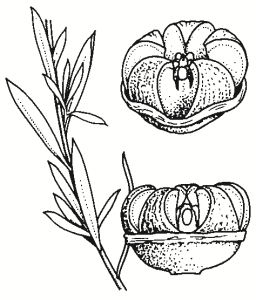Family:
Myrtaceae
Leptospermum polygalifolium
Lemon-scented Tea-tree
(syn. L. flavescens)
Other Names: Tantoon, Tantoon Teatree.

Name Origin:
polygalifolium – from Latin meaning leaves similar to those in genus Polygale.
Regional Subspecies:
Occurrence:
Regional:
Noted in Munderoo district. Possibly also in surrounding areas.
Australia:
Qld, NSW.
Habitat:
Sandy soil or on sandstone or basalt soils, and along rocky watercourses.
Habit:
Shrub or small tree 1-7 m high with firm, but soft smooth bark. Narrow leaves 5-20 mm long.
Site Preference:
Resists frost.
Characteristics:
Fast-growing. Lifespan up to several decades.
Flowering:
Aug-Jan. Often profuse and honey-scented.
Propagation:
From seed or cuttings.
VALUES:
Shade & Shelter:
Good low-level cover in windbreaks.
Land Protection:
Excellent for stabilising creeks and riverbanks due to soil-binding fibrous roots. It also protects banks as it is flexible enough to lie down in floods due to the weight of fast-flowing water.
Wildlife:
Good streamside habitat.
Timber:
Close-grained, hard, tough and light-coloured.
Ornamental:
Attractive garden specimen. Prune to encourage bushiness.
Other:
Lemon-scented leaves occasionally used as tea substitute in colonial times.
